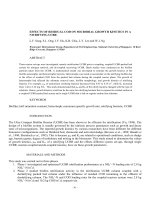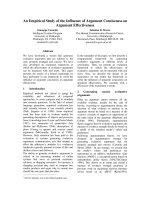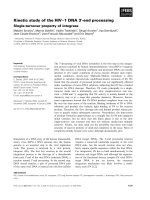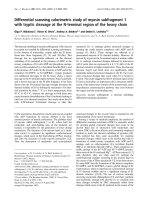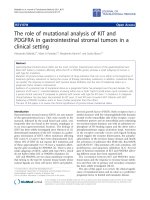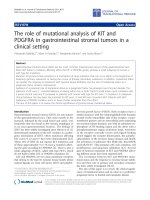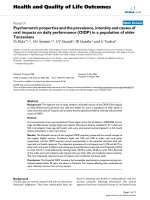Study of the effectiveness of 1 % sodium hypochlorite on blood samples discarded in a clinical laboratoryStudy of the effectiveness of 1 % sodium hypochlorite on blood samples discarded in
Bạn đang xem bản rút gọn của tài liệu. Xem và tải ngay bản đầy đủ của tài liệu tại đây (237.77 KB, 6 trang )
��������������������������������������������������������������������������������������������������������������������������������������������������������������������������������������������������������������������������������������������������������������������������������������������������������������������������������������������������������������������������������������������������������������������������������������������������������������������������������������������������������������������������������������������������������������������������������������������������������������������������������������������������������������������������������������������������������������������������������������������������������������������������������������������������������������������������������������������������������������������������������������������������������������������������������������������������������������������������������������������������������������������������������������������������������������������������������������������������������������������������������������������������������������������������������������������������������������������������������������������������������������������������������������������������������������������������������������������������������������������������������������������������������������������������������������������������������������������������������������������������������������������������������������������������������������������������������������������������������������������������������������������������������������������������������������������������������������������������������������������������������������������������������������������������������������������������������������������������������������������������������������������������������������������������������������������������������������������������������������������������������������������������������������������������������������������������������������������������������������������������������������������������������������������������������������������������������������������������������������������������������������������������������������������������������������������������������������������������������������������������������������������������������������������������������������������������������������������������������������������������������������������������������������������������������������������������������������������������������������������������������������������������������������������������������������������������������������������������������������������������������������������������������������������������������������������������������������������������������������������������������������������������������������������������������������������������������������������������������������������������������������������������������������������������������������������������������������������������������������������������������������������������������������������������������������������������������������������������������������������������������������������������������������������������������������������������������������������������������������������������������������������������������������������������������������������������������������������������������������������������������������������������������������������������������������������������������������������������������������������������������������������������������������������������������������������������������������������������������������������������������������������������������������������������������������������������������������������������������������������������������������������������������������������������������������������������������������������������������������������������������������������������������������������������������������������������������������������������������������������������������������������������������������������������������������������������������������������������������������������������������������������������������������������������������������������������������������������������������������������������������������������������������������������������������������������������������������������������������������������������������������������������������������������������������������������������������������������������������������������������������������������������������������������������������������������������������������������������������������������������������������������������������������������������������������������������������������������������������������������������������������������������������������������������������������������������������������������������������������������������������������������������������������������������������������������������������������������������������������������������������������������������������������������������������������������������������������������������������������������������������������������������������������������������������������������������������������������������������������������������������������������������������������������������������������������������������������������������������������������������������������������������������������������������������������������������������������������������������������������������������������������������������������������������������������������������������������������������������������������������������������������������������������������������������������������������������������������������������������������������������������������������������������������������������������������������������������������������������������������������������������������������������������������������������������������������������������������������������������������������������������������������������������������������������������������������������������������������������������������������������������������������������������������������������������������������������������������������������������������������������������������������������������������������������������������������������������������������������������������������������������������������������������������������������������������������������������������������������������������������������������������������������������������������������������������������������������������������������������������������������������������������������������������������������������������������������������������������������������������������������������������������������������������������������������������������������������������������������������������������������������������������������������������������������������������������������������������������������������������������������������������������������������������������������������������������������������������������������������������������������������������������������������������������������������������������������������������������������������������������������������������������������������������������������������������������������������������������������������������������������������������������������������������������������������������������������������������������������������������������������������������������������������������������������������������������������������������������������������������������������������������������������������������������������������������������������������������������������������������������������������������������������������������������������������������������������������������������������������������������������������������������������������������������������������������������������������������������������������������������������������������������������������������������������������������������������������������������������������������������������������������������������������������������������������������������������������������������������������������������������������������������������������������������������������������������������������������������������������������������������������������������������s was to find the actual
concentration and time of exposure required
for effective decontamination of blood
associated pathogens in the microbiology
laboratory of the rural tertiary care hospital.
Study period was for a period of three and a
half months (3rd Feb. 2016 to 19th May 2016).
Daily discarded vacutainers were put into a
designated double bucket (Fig. 1) with a
separate lid. Using appropriate Personal
Protective Equipments (PPE), vacutainer caps
were opened to allow the contact of Sodium
hypochlorite with the blood sample. A pretest
sample of blood was collected using a sterile
microbiological loop and directly streaked on
to the Blood and Mac Conkey media. Freshly
Samples were collected on 74 days during the
study period which yielded 123 bacterial
isolates (Some of the samples grew more than
one organism) in the samples collected before
exposure to 1 % Sodium hypochlorite. Details
of the samples yielding number of organisms
are given in Table 1. Bacterial cultures were
grown in 72 % of the samples tested. Most of
the samples tested had one (32.43 %) or two
(14.86 %) organisms. There was no growth in
20 samples (27 %) tested. Sample distribution
is depicted in Table 2. Important organisms
isolated were Pseudomonas (around 25 %), E.
coli (17.89 %) and Non – fermenting Gram
negative bacteria – NFGNB (14.63 %).
Table.1 Depicting the number of organisms isolated per sample
No
growth
20
27.03
one
Two
Three
Four
Total
organism organisms organisms organisms
24
16
11
3
74
32.43
21.62
14.86
4.05
100.00
3691
Int.J.Curr.Microbiol.App.Sci (2018) 7(8): 3689-3694
Table.2 Depicting the distribution of study isolates before exposure to 1 % Sodium hypochlorite
(n = 123)
Organism
No. of isolates
Aerobic spore bearers
6
1
Burkholderia spp.
10
CONS
22
E. coli
2
Enterococcus spp
5
Klebsiella pneumoniae
3
Klebsiella spp
2
Micrococci
18
NF GNB
20
No growth
1
Proteus spp
Pseudomonas aeruginosa 30
1
Pseudomonas spp.
2
Streptococcus spp.
Total
123
Percentage
4.88
0.81
8.13
17.89
1.63
4.07
2.44
1.63
14.63
16.26
0.81
24.39
0.81
1.63
100.00
Table.3 Effect of exposure time of 1 % Sodium hypochlorite on different Bacteria isolated from
the stored vacutainers beyond 72 hours
Bacteria isolated from
Neat sample
Time of exposure
blood stored in vacutainers (Before exposure) 10 Min. 20 Min. Over night
6
0
0
0
Aerobic spore bearers
1
0
0
0
Burkholderia spp.
10
0
0
0
CONS
22
0
0
0
E. coli
2
0
0
0
Enterococcus spp
5
0
0
0
Klebsiella pneumoniae
3
0
0
0
Klebsiella spp
2
0
0
0
Micrococci
18
0
0
0
NF GNB
20
0
0
0
No growth
1
0
0
0
Proteus spp
30
0
0
0
Pseudomonas aeruginosa
1
0
0
0
Pseudomonas spp.
2
0
0
0
Streptococcus spp.
3692
Int.J.Curr.Microbiol.App.Sci (2018) 7(8): 3689-3694
Fig.1 Photograph depicting the double bucket used for disinfection of vacutainers
Effect of exposure time on the organisms to 1
% Sodium hypochlorite is depicted in Table 3
wherein, all the 123 organisms exposed were
killed within 10 minutes of exposure. The
exposure time of just 10 minutes was
sufficient to kill all the bacterial isolates
studied. Efficacy of 1 % Sodium hypochlorite
was maintained at the maximum, since the
dilution was prepared afresh, every time the
study was conducted. BMW rule is
mandatory, legal and traceable. All infected
materials should be decontaminated at source
itself and this is stringently followed up.
BMW rule of 2018 states that all laboratory
samples are decontaminated at source. The
requirement of the percentage of Sodium
hypochlorite to be used in the form of
disinfectant is still debated (Chitnis et al.,
2002). Though CDC recommends the use of 1
% Sodium hypochlorite to decontaminate the
biomedical waste, some question the safety
and recommend upto 10 %. Higher doses of
hypochlorite increase the release of more
quantities of free chlorine which is a toxic gas
(Doris Horvath). So the sodium hypochlorite
required to be used in optimum doses to
achieve effective disinfection without
affecting the health of the personnel involved
need to be evaluated in the laboratory.
In the current study, a total of 123 bacterial
isolates were studied on 74 samples of blood
vacutainers which were stored over 72 hours.
The current study helps to prove the clinical
hypothesis (CDC guidelines) that 1 % of
Sodium hypochlorite is sufficient to achieve
total disinfection of blood samples within 10
minutes of exposure. Further studies are
required to identify the lowest concentration
of Sodium hypochlorite required to disinfect
different laboratory samples before they are
discarded.
Acknowledgement
The authors wish to thank the management
for all the encouragement to take up this study
and to the staff of Department of
3693
Int.J.Curr.Microbiol.App.Sci (2018) 7(8): 3689-3694
Microbiology, PESIMSR, Kuppam, AP for
their support.
References
Block, S. S. 1991. Historical review, p. 3–17.
In S. S. Block (ed.), Disinfection,
sterilization, and preservation, 4th ed.
Lea & Febiger, Philadelphia, Pa.
Rutala, W. A., and D. J. Weber. 1995. Use of
chemical germicides in the United
States: 1994 and beyond, p. 1–22. In
W. A. Rutala (ed.), Chemical
germicides in health care. Association
for Professionals in Infection Control
and Epidemiology, Inc., Washington,
D.C., and Polyscience Publication,
Morin Heights, Canada.
Denys, G. A. 1989. Microbiological
evaluation of the medical SafeTEC
mechanical/chemical infectious waste
disposal system, abstr. Q-57. In
Abstracts of the 89th Annual Meeting
of the American Society for
Microbiology 1989. American Society
for Microbiology, Washington, D.C.
Dakin, H. D. 1915. On the use of certain
antiseptic substances in the treatment
of infected wounds. Br. Med. J.
2:318–320.
Dychdala, G. R. 1991. Chlorine and chlorine
compounds, p. 131–151. In S. S.
Block (ed.), Disinfection, sterilization,
and preservation, 4th ed. Lea &
Febiger, Philadelphia, Pa.
Ellis, K. V. 1991. Water disinfection: a
review with some consideration of the
requirements of the third world. Crit
Rev Environ. Control 20:341–407.
William A. Rutala and David J. Weber (1997)
Uses of Inorganic Hypochlorite
(Bleach) in Health Care Facilities –
Clinical Microbiology Reviews; 10:
597 – 610).
Doris Horvath (1992) Chlorine, chlorine
compounds and their environmental
impact. In: STOA Scholar seminar
report. pp 1 – 42.
BMW Rule BMW Rule (2016) [Published in
the Gazette of India, Extraordinary,
Part II, Section 3, Sub-section (i)] pp 1
– 37.
BMW Rule 2018 (2018) [Published in the
Gazette of India, Extraordinary [PART
II—SEC. 3(i)] pp 1 – 12.
V Chitnis, DS Chitnis, S Patil, S Chitnis
(2002)
Hypochlorite
(1%)
is
inefficient in decontaminating blood
containing hypodermic needles. Indian
Journal of Medical Microbiology,
(2002) 20 (4):215-218.
How to cite this article:
Sneha Kukanur, C. Nagaraj and Latha, G. 2018. Study of the Effectiveness of 1 % Sodium
Hypochlorite
on
Blood
Samples
Discarded
in
a
Clinical
Laboratory.
Int.J.Curr.Microbiol.App.Sci. 7(08): 3689-3694. doi: />
3694

